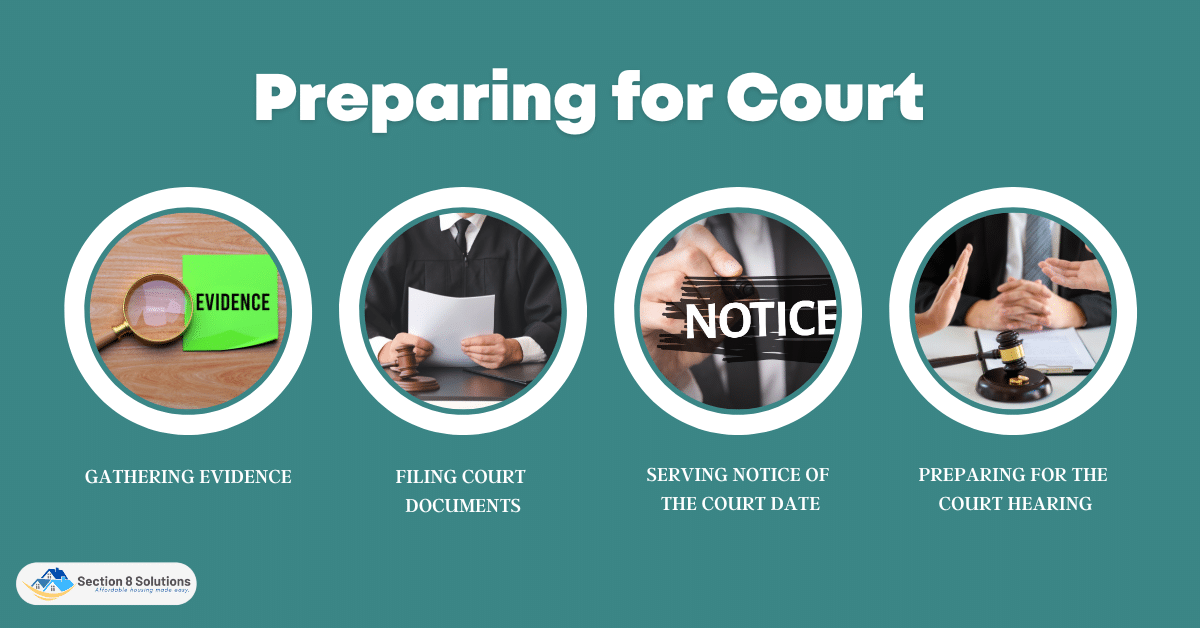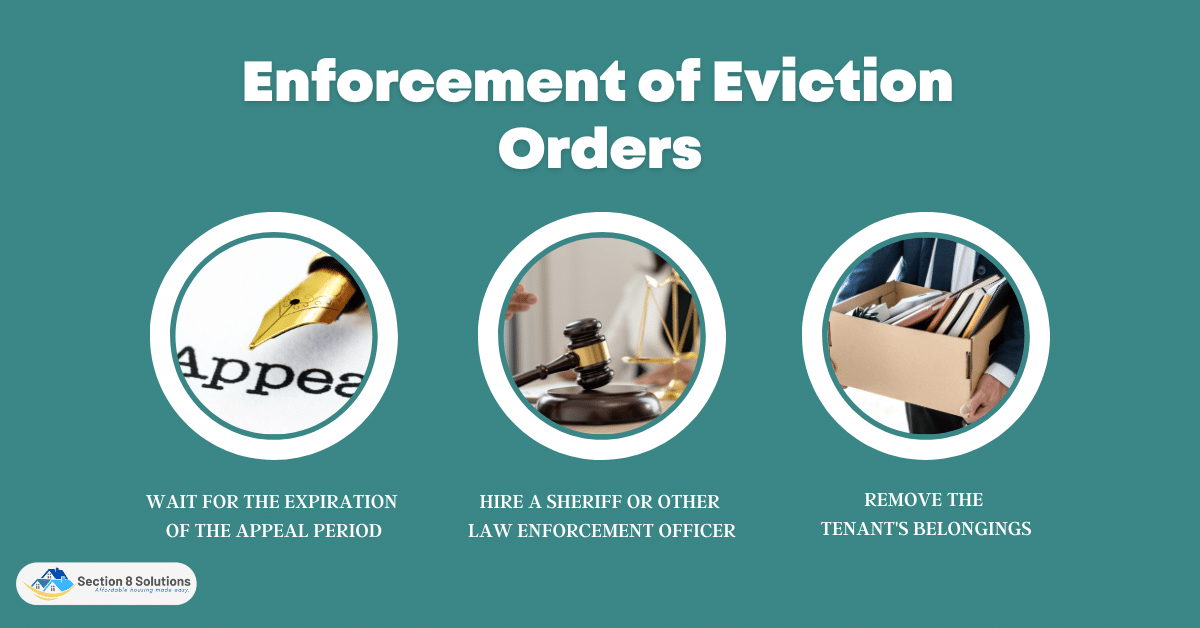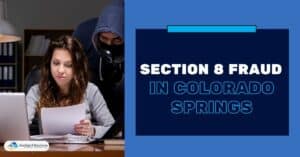Evicting a tenant can be a difficult and emotionally charged process for a first-time landlord. It is important to have a clear understanding of your local laws and regulations regarding eviction and to follow them carefully. Communicating with your tenant clearly and respectfully can also reduce friction and make the transition easier.
This guide aims to provide a comprehensive overview of the eviction process for first-time landlords, covering everything from understanding eviction laws to communicating with tenants, preparing for court, and enforcing eviction orders.

Understanding Eviction Laws
Local eviction laws vary, so landlords must know them. Eviction notices must be understood. Notices to Pay Rent or Quit, Cure or Quit, and Unconditional Quit Notice are eviction notices. A Notice to Pay Rent or Quit is used for late rent, while a Notice to Cure or Quit is for lease violations.
Non-payment of rent, lease violations, illegal activities, property damage, and unwillingness to leave after the lease expires are valid grounds for eviction. Thus, landlords must know the eviction reason to follow the law. After determining the basis for eviction, a landlord must follow legal procedures to evict.
This comprises giving the tenant a written notice of the basis for eviction and the deadline for compliance or departure. It also requires submitting documentation to the local court and serving the renter with a copy of the court summons and complaint.
Finally, local laws must be followed. These requirements must be followed to avoid delays, fines, or legal action against the landlord. To comply with all rules and regulations, consult a lawyer. Landlords can prevent costly mistakes and handle the eviction process with confidence by learning the many forms of eviction notifications, legal reasons for eviction, and mandatory measures.

Communication With Tenants
Effective communication during the eviction process can change the outcome. Landlords must openly and respectfully explain the situation and eviction to renters. Failure to communicate can cause misunderstandings, and arguments, and extend the eviction process, costing both the landlord and renter.
Clear and respectful communication might help the renter comprehend the eviction and how to comply with the contract. Landlords should give tenants formal notices, such as a Notice to Pay Rent or Quit, to explain the situation and the deadline for compliance or eviction. Talking to the tenant about the eviction and possible remedies is also crucial.
Effective communication reduces conflict and streamlines evictions. Be respectful, listen to the renter, and don’t use emotive words. Landlords should try to establish a mutually agreeable agreement.

Preparing for Court
Preparing for court is a crucial step in the eviction process for landlords. It involves gathering evidence, filing court documents, serving the tenant with notice of the court date, and preparing for the court hearing. In this section, we will discuss the essential steps involved in preparing for court and how landlords can increase their chances of a successful outcome in the eviction process.

1. Gathering Evidence
Eviction preparation requires gathering evidence. Lease agreements, rent receipts, written notices, and other eviction documentation must be collected. This evidence can help the landlord prove the tenant’s lease breach or rent nonpayment.
Landlords may also want photos or videos of the property. This can include photos or videos of tenant damage, the property’s condition when the tenant moved in, and unauthorized occupants or pets.
2. Filing Court Documents
To successfully evict, court documentation must be filed correctly. Check with the local court to see what papers and documentation are needed to file an eviction case. It’s important to check the local laws.
Fill out the essential papers and documents carefully and accurately. To make the case clear, provide all relevant information and documents. Before submitting documents to the court, check for completeness and accuracy.

3. Serving Notice of the Court Date
After filing the eviction action, serve the renter the court date and time notice. To ensure legality, this notification must be served in accordance with local legislation.
The renter must receive the court date and time in person, by certified mail, or by a process server. The local court and jurisdiction determine the delivery method, thus it’s necessary to confirm.
4. Preparing for the Court Hearing
Landlords can prepare for the court hearing by reviewing all evidence and court documents to ensure completeness and accuracy. They should also prepare a written summary of the case and key points to be emphasized during the hearing. Additionally, it’s important to dress appropriately and arrive at the court on time.
Landlords should seek legal advice before going to court. Landlords can improve their eviction chances by gathering evidence, filing court paperwork, serving notice, and preparing for court appearances.

Enforcement of Eviction Orders
After the court has issued an eviction order, it is the responsibility of the landlord to enforce it. The following are the steps involved in removing a tenant from the property:

Orders
- Wait for the expiration of the appeal period: Once the court has issued an eviction order, the tenant may have a certain number of days to file an appeal. Landlords must wait for this period to expire before taking further action.
- Hire a sheriff or other law enforcement officer: If the tenant has not vacated the property after the appeal period has expired, the landlord can hire a sheriff or other law enforcement officer to physically remove the tenant from the property. The officer will typically provide the tenant with a notice to vacate before proceeding with the eviction.
- Remove the tenant’s belongings: Once the tenant has been removed from the property, the landlord can remove any belongings left behind by the tenant. In some jurisdictions, the landlord may be required to store the tenant’s belongings for a certain period of time.
It’s important to note that the process of removing a tenant from the property can be time-consuming and costly, and landlords should be prepared to follow all applicable laws and regulations.
After the Eviction
Once the tenant has vacated the property, landlords need to take care of several tasks, such as repairs and cleaning, handling any outstanding debts, and finding a new tenant. The following are some tips on how to handle these tasks:
- Repairs and cleaning: Landlords should inspect the property after the tenant has vacated to identify any necessary repairs or cleaning. If the tenant caused damage beyond normal wear and tear, landlords may be able to deduct the cost of repairs from the security deposit. Otherwise, landlords should return the deposit to the tenant promptly.
- Handling outstanding debts: Landlords should review the lease agreement to determine if the tenant owes any outstanding debts, such as unpaid rent or damages to the property. If so, landlords should make every effort to collect the debt. In some cases, it may be necessary to take legal action to recover the debt.
- Finding a new tenant: Once the property is ready, landlords can start looking for a new tenant. They should consider advertising the property online or in local newspapers, screening potential tenants carefully, and requiring a security deposit and first month’s rent upfront.
Overall, handling the aftermath of an eviction can be stressful and time-consuming, but it’s important for landlords to take care of these tasks thoroughly to avoid future problems.

Conclusion
Evicting a tenant can be a challenging and emotional process for first-time landlords. However, by understanding the legal requirements, communicating clearly with tenants, and preparing for court, landlords can successfully navigate the eviction process.
Throughout the guide, we discussed the different types of eviction notices, legal reasons for eviction, steps required by law to begin the eviction process, and ways to communicate with tenants. We also covered how to gather evidence, file court documents, serve notice of the court date, prepare for the court hearing, and enforce eviction orders.












